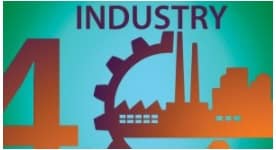Industry 4.0 is a catchphrase and buzzword that you can no longer afford to ignore. This fourth phase of the Industrial Revolution isn’t just about the increased digitization of manufacturing. It’s not just about advances in automation either. Industry 4.0 could change how your company competes and whether or not you’ll continue to win. Industry 4.0 isn’t just about technology. It’s about profitability.
What Is Industry 4.0?
Industry 4.0 is a term that most manufacturers recognize, but that few can fully define. The media hype doesn’t help. The fact that manufacturing experts have different definitions adds to the confusion. For the purposes of this article, we’ll define Industry 4.0 as a family of technologies that use a cyber-physical interface to improve how humans and machines interact in order to add business value.
Which technologies are part of the Industry 4.0 family? Here’s what we’re including:
- Robotics and advanced human-machine interfaces
- The Industrial Internet and the Internet of Things (IoT)
- Big Data and cloud computing
- Simulations and augmented reality
- Horizontal, vertical, and customer system integration
- Additive manufacturing (3D printing)
- Cybersecurity
Unfortunately, some of these “family members” are also buzzwords whose meaning has been diluted by misuse and overuse. There’s also a common misunderstanding that Industry 4.0 is revolutionary because it’s about the digitization of manufacturing or the use of automation. Remember: neither digitization nor automation are new. What’s revolutionary is how they’re being used together – and with people.
Smart Factories and Warehouses: Three Examples
Let’s look at some examples of Industry 4.0 in the real world.
Harley Davidson is an iconic motorcycle manufacturer that consolidated operations from 42 old buildings into one new factory. The company’s York, Pennsylvania facility uses digital control systems, automated guided vehicles, tablet PCs, and wireless digital signage. This facility has reduced production cycles from a fixed 21-days to a six-hour horizon. Worker injuries are also down by 91%.
General Electric is a multinational conglomerate with roots that reach back into the nineteenth century. At its gas turbine plant in Greenville, South Carolina, GE uses advanced manufacturing equipment with sensors, industrial networks, and advanced software for data analysis. Thanks to these investments, GE’s smart factory realized a $100 million productivity savings across the entire facility in three years.
Knapp AG is a German logistics company that has developed a human-machine interface for picking. Workers wear a headset with an integrated camera and see-through display. The camera captures serial and lot numbers for real-time stock tracking. The headset presents workers with item information and lets them keep both hands free for picking. This human-machine interface has reduced error rates by 40%.
How Industry 4.0 Drives Value
As these examples show, Industry 4.0 isn’t just about new technologies. It’s about getting business value from these investments. According to McKinsey & Company, a worldwide management consulting firm, Industry 4.0 provides options, or “levers”, for value drivers – anything that can be added to a product or service to increase its value to customers. This table explains.
| Value Drivers | Industry 4.0 Levers |
| Resource / Process | Smart energy consumptionIntelligent lots
Real-time yield optimization |
| Asset Utilization | Routing flexibilityMachine flexibility
Remote monitoring and control Predictive maintenance Augmented reality for maintenance, repair, and operations (MRO) |
| Labor | Human-robot collaborationRemote monitoring and control
Digital performance management Automation of knowledge-work |
| Inventories | Batch sizeReal-time supply chain optimization
On-site 3D printing |
| Supply / Demand Match | Data-driven design to valueData-driven demand production |
| Quality | Digital quality managementAdvanced process control
Statistical process control |
| Time to Market | Rapid experimentation and simulationConcurrent engineering
Customer co-creation / open innovation |
| Service / After-Sales | Predictive maintenanceRemote maintenance
Virtually guided self-service |
Industry 4.0 and You
According to the Boston Consulting Group, a majority of larger manufacturers (53%) see the adoption of Industry 4.0 as a priority. Yet a sizable percentage of smaller companies are uncertain about what Industry 4.0 really means. Unsurprisingly then, approximately one-third of smaller manufacturers (34%) do not have plans to develop or implement an Industry 4.0 strategy.
Is your company ready for Industry 4.0? What are you doing about this fourth phase of the Industrial Revolution? Are you considering specific technologies? Maybe you’ve implemented some aspects of Industry 4.0 instead. Regardless of where you are in your journey, we hope this article has been helpful. We also invite you to share your thoughts by commenting on this blog entry.
Related Topics
Industry 40 Real World humans machines interact Industry 40 Real World humans machines interact Industry 40 Real World humans machines interact Industry 40 Real World humans machines interact Industry 40 Real World humans machines interact Industry 40 Real World humans machines interact


